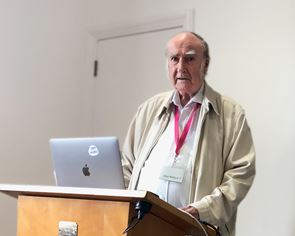Professor Alan R Millard (1937–2024)
News
7th June 2024

When I was a teenager I came to know the name of Alan Millard as someone who was a genuine expert on archaeology and the Bible.
He inspired a family member of mine to buy books about Hebrew, which eventually led me to learn that language. I finally met this legend when he was interviewing me as a prospective undergraduate student of Liverpool University. Though I didn’t actually go to study with him, he kept in correspondence with me and would periodically send me academic articles. He remained a mentor for decades and over time I realised that he was doing the same with many others.
He was prolific as an author, publishing on a large range of subjects. Early in his career he made the discovery of a rather special clay tablet in a drawer in the British Museum. He recognized it as an important account of the Babylonian Flood Story and thus he went on to publish (with W.G. Lambert) an authoritative edition of the epic of Atrahasis. He also published The Eponyms of the Assyrian Empire – important for providing the backbone of chronology of the early first millennium BC. But he also authored popular books like Discoveries from the Time of Jesus.
He was heavily involved in both Tyndale House and the Tyndale Fellowship and is mentioned on approximately one in every six pages of Tom Noble’s Tyndale House and Fellowship: The First Sixty Years. He chaired the Tyndale House Council and later chaired the Archaeology study group of the Tyndale Fellowship. But he was also involved behind the scenes in many ways. For instance, he was a stalwart peer reviewer for the Tyndale Bulletin when I was its editor. The story cannot be told of all the manuscripts he helped to publication (or to steer towards another fate).
He was sufficiently well versed in Classical scholarship that while he was Librarian at Tyndale House from 1964 to 1970 he would not allow the Loeb Classical Library series to be stocked in the library because he expected that any decent scholar would find the English translation unnecessary.
By conviction and by association he was an evangelical scholar, who revered the Bible. But his learning was of a calibre that no one could dismiss. He never put his name to something that was not thoroughly grounded. Throughout his entire life not once did he adopt a remotely sensationalist interpretation, which is really quite remarkable for someone so involved in biblical archaeology and regularly explaining discoveries to lay audiences. We can see this by contrasting his cautious evaluation of the Khirbet Qeiyafa ostracon with those of various others:
Where some might find in this text the ideas of Deuteronomy from the time of David, Millard concludes:
‘The Khirbet Qeiyafa ostracon reveals nothing directly about the kingdom of David and Solomon! Since there is no proof the text is written in Hebrew rather than Canaanite, we cannot say it is an Israelite product. Indeed, the fortified hill-top, standing as it does on the north side of the valley of Elah, on the frontier between Israel and Philistia, could have been in Canaanite, Israelite, or Philistine hands when the ostracon was written.’ (p. 12)
Millard modelled cautious conclusions in the context of biblical archaeology and that rightly earned the respect of others. But despite his caution and seeming to be personally shy, he would not hesitate to stand up within a room full of scholars and make a point from the evidence when he felt it was being ignored.
Alan warned me early on not to get involved in writing commentaries on the Bible since there were too many people already involved in this and it actually took energy away from making scholarly discoveries. I’m sure commentary writing is the right thing for some, but I’m so glad that he himself personally focussed on finding new things which others could put into commentaries.
He was married to his much beloved Margaret for 54 years until her death in 2019.
I will miss him and know many others will too. There will be some posthumous publications, but it’s too early to say how many. As one scholar commented when we discussed Millard’s forthcoming publications, ‘He’s being more productive after death than I am in life.'
Peter J. Williams
Principal
Tyndale House

When I think about Alan Millard, I think of him as a personal adviser and friend, as a scholar, as well as a fine Christian gentleman. Especially, he guided the Genesis Project of Tyndale House, and he, together with Profs. D. J. Wiseman and K. A. Kitchen, invited me to participate in it during 1986–88. Later, Alan twice visited Japan to present special biblical archaeology lectures for our Tokyo Museum of Biblical Archaeology (TMBA), supporting and encouraging our small museum. The second time, he and his wife Margaret enjoyed visiting places like Kyoto and having fellowship with other scholars and Christians. One of the notable occasions in Japan was his lecture on ancient Syrian inscriptions, which nearly two hundred people attended. Alan was a generous and helpful scholar who advised and shared his vast knowledge of ANE with many international scholars, even in Japan.
David Toshio Tsumura
Emeritus Professor
Japan Bible Seminary